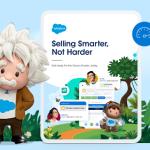Employees have made it loud and clear they want more than a paycheck from their jobs. Among the biggest contributors to a great employee experience, according to new Salesforce research, is a sense of purpose. Many businesses have responded by focusing more on purpose and impact on society. But there’s an often overlooked element of that new focus: paid volunteering, or volunteer time off programs.
From the Corporate Giving Study 2021 conducted by NVPC, 42.3% of the companies surveyed in Singapore include corporate giving in their business policies. Within this percentage, only 11% allocate paid volunteer time off (VTO) benefit, despite the fact that companies with a culture of volunteerism have better morale, retention, employee engagement, and brand perception.
Many companies offer employees some kind of volunteer opportunity, but it’s often a single day of volunteering or raising money for charities.
Learn how Daughters Of Tomorrow uses Salesforce to help low-income women skill up, gain confidence, and find employment.



Make volunteer time off a core part of employee engagement
Salesforce was founded on the principle that businesses can have great social impact. The company offers employees an above-average VTO benefit of 56 hours, or 7 business days, each year. They can use that time to volunteer for one of the nonprofits Salesforce formally supports — the company has pledged millions of dollars to support education, workforce development, and climate justice initiatives — or one of their own choosing.
We’ve learned a lot over the years about how VTO impacts our workforce and the community. We’re happy to share our expertise and best practices here.
Team Earth has landed
Businesses that live their values by fixing what’s broken are doing good for the world in general. Things like equal access, opportunities, and rights for all. We call this being part of Team Earth.



According to Jamie Olsen, senior director of Citizen Philanthropy at Salesforce, about 75% of the company’s 73,000-person global workforce participates in the VTO program, with about 25% using the whole 56-hour allotment.
“These are the types of programs that people want and that are attracting them to companies right now,” she said. “They better the community. They improve people’s happiness. They make them feel more engaged when they are sitting at their desk.”
The recent global research by Deloitte found that the younger generation workers are seeking balance and sustained change. Many are concerned about the state of the world and how companies can make work more purpose-driven.
Companies that create aspirational workplaces foster a culture of inclusion, purpose, listening, caring, and empathy.
How to establish your own VTO program
Salesforce has donated more than $530 million and 7.3 million hours since our founding. The company might be an outlier in the resources it devotes to VTO programs — Olsen’s team, for example, has 25 people dedicated to it — but there are steps that you can take to establish your own VTO initiatives. Here are some tips:
Self-service digital options
Build volunteer engagement programs that align with your strategic focus areas or what your business focuses on. While employees should be free to volunteer however they choose, try to steer them toward opportunities where you’re already making a financial commitment. Try to pair employees with organisations that support them.
Focus on important goals
Think about your specific goals rather than spending time or money on any problems. What change do you want to affect, and where can you have the biggest impact? Formalise your goals in writing, and make sure all employees are aware of them and how they can participate. Doing so will give everyone something to rally around.
Plan with scale in mind, but within the budget you have
Think several steps ahead, considering all the different factors that might come into play. For example, Salesforce used to award employees who hit certain VTO milestones with donations to their cause, with no cap. When that became unsustainable, we reworked the programs while still recognising the employee’s efforts.
Track activity
Use tools that help employees find opportunities that align with organisational initiatives. Salesforce built its own digital tool, Volunteerforce, that lets employees log their VTO hours, organise team volunteer activities, and search for opportunities by skill, project type, duration, and location.
“I think a lot of companies start managing this with Excel spreadsheets, or with someone in HR managing this off to the side, but that quickly becomes unscalable and unsustainable,” said Olsen. There are several companies that provide volunteer tracking apps.
Incentivise employees by creating impact milestones
At Salesforce, employees who hit at least 7 milestones — repeat volunteer engagements, donating skills, joining a board, organising a team event, etc. — are entered into a lottery for a grant to an eligible organisation of their choice. That’s in addition to standard company matches to eligible organisations.
Volunteer time off is the evolution of employee engagement
It’s easier to measure the impact of corporate giving for the recipients than it is to measure the impact of VTO on employee engagement and morale. How does Salesforce measure employee impact? Olsen’s team collects survey data to better understand how employees are inspired to connect with the community in meaningful and sustainable ways.
“We also look at participation in our programs, and how many people are hitting each of the impact milestones,” Olsen said.
She said 13,500 employees have hit at least seven impact milestones.
Over the last few years, much has been made about the importance of purpose-driven employment. Lately, quiet quitting, where workers collect a paycheck by doing the minimum and no more, has made headlines. But here’s the thing — is quiet quitting really about slacking off at work, or about employers giving employees the freedom to lead a more purposeful, fuller life outside their jobs?
In an age when businesses are expected to engage in social issues in bigger and more visible ways, the next step is giving employees the tools, support, and time they need to do just that.
Prioritise employee engagement to boost morale, productivity, and retention.
This post originally appeared on the U.S.-version of the Salesforce blog.

























